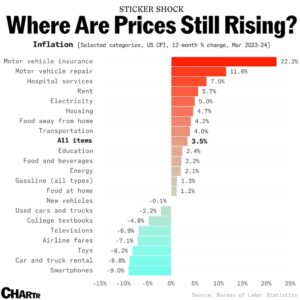
The Jamaica Exception
“The main two things that bring down a great nation are war and debt,” says Bill Bonner in the April 17 issue of Bonner Private Research, “and the US is not backing away from either of them.”
In this essay, Bill talks about how some countries in recent years have managed to avoid complete financial collapse by persuading their voters to go along with debt-reduction plans. But that is not even on the agenda of any of America’s politicians. Both Biden and Trump have proven to be relentless borrowers and spenders of taxpayer income. And neither has spoken a word about debt-reduction. The Biden administration, meanwhile, is moving us closer and closer to large-scale war.
Is there anything that can be done about it? Or should we, as individuals, privately plan for the worse?
Chart of the Week: Hot Inflation?
This week, Sean talks about an important subject I’ve never felt I understood well enough to bet on it: the government’s data on inflation. I’m guessing you feel the same way, so I’m going to turn this into an opportunity for you to learn from Sean along with me. I’m going to tell him what I think I know about this particular area of economics… ask him to correct or validate my ideas… and then report back to you on Wednesday. – MF
Inflation came in hot in March, and now many people are asking whether this will delay Fed rate cuts.
As The Wall Street Journal reports, Fed Chair Jerome Powell “said firm inflation during the first quarter had introduced new uncertainty over whether the central bank would be able to lower interest rates this year.”
But I’m currently a little skeptical of this.
Inflation is not uniform. It doesn’t affect every commodity the same way, nor does it affect every region at the same time.
We can see that pretty clearly if we look at the major contributors to the consumer price index (CPI) inflation model over the last year:

While some major expenses like housing, electricity, and car repairs are pulling inflation up, we see food at home, vehicle costs, and other travel expenses pulling inflation down.
But since the recent “hot” inflation rating, many Wall Street prognosticators have taken to saying that there will not be a Fed rate cut anytime soon. Some even say that another rate hike is in order.
But, again, take a look at the chart above. Specifically, look at the rise in motor vehicle insurance and repair.
You have to ask yourself some simple questions:
* How would Fed interest rates work to quickly tamp down car insurance and car repair prices?
* Is this reading a chronic or acute problem?
* Can this be better explained by something else?
On that last note, let’s do a bit of logical thinking with car insurance and repair costs.
In the last few years, after new car manufacturing declined in 2020/2021, people resorted to buying used cars.
When people buy a lot of a thing, supply goes down and prices go up. This can show up in inflation models.
What do we know about used cars?
We know that older cars have higher failure rates, defect rates, accident rates, and fatality rates. We also know that older cars require more maintenance.
If you buy something that causes more accidents, has a higher chance of killing you, and costs more to repair…
Doesn’t it make sense that the surge in used car purchases in 2022 might cause a surge in car insurance and repair costs in 2023?
Now that used car prices have been deflating over the last year, we should also see insurance and repair prices level out a bit on their own in the months ahead. Without monetary policy intervention.
We can apply this same logical exercise to most of the categories seeing high inflation right now.
So right now, I am still thinking that the Fed might still be on track for at least one rate cut later on in 2024…
And I’ll explain why in more detail in next week’s column.
– Sean MacIntyre
Check out Sean’s YouTube channel here.
